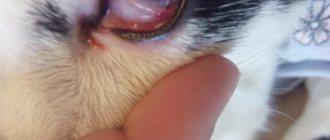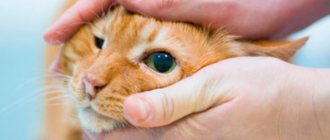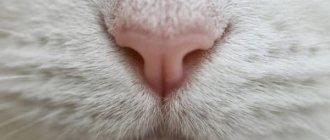The medical term for blood in a cat's urine is hematuria. The appearance of blood in a portion of urine excreted by a cat is an alarming signal for the cat’s owner. The cause of the pathology may be associated with a large number of different diseases of the internal organs.
In the vast majority of clinical cases, hematuria indicates a disturbance in the functioning of the urinary system. Infectious diseases, urolithiasis, and adrenal tumors can provoke the appearance of blood fractions in the urine. It is worth paying close attention to the appearance of an alarming symptom and it is recommended to consult a veterinarian for advice, diagnosis and subsequent treatment.
It is important to understand that hematuria is considered not only the release of blood into the urine in an unchanged form - scarlet color. Hematuria may be indicated by brown urine. This phenomenon occurs due to the release of blood gradually and decomposition processes begin in it, occurring in the bladder area.
What does urine normally look like in cats?
Normal pet urine is clear and may be pale yellow, straw, or orange in color. In many ways, the shade of urine is determined by the nature of the cat’s metabolism and its diet. It contains no inclusions. Removing decay products, salts, enzymes, vitamins, and foreign substances from the body, normally animal urine does not have a sharp, specific odor.
Blood in a cat's urine - causes
Blood in a cat’s urine may be a consequence of disturbances in the functioning of the organs of its genitourinary tract or the presence of various diseases. These include:
- urolithiasis (urolithiasis);
- cystitis (inflammation of the bladder);
- pyelonephritis (inflammation of kidney tissue);
- diphtheria vaginitis (inflammation of the vaginal mucosa);
- other pathological conditions.
Also, blood in a cat’s urine can appear in animals whose bodies are undergoing infectious processes (one of the symptoms of viral peritonitis, piroplasmosis, leptospirosis). The manifestation of this symptom is typical for pets with oncology and cats diagnosed with helminthic infestation.
Hematuria can develop while taking certain medications: cytostatics, non-steroidal anti-inflammatory drugs, corticosteroids. As a temporary phenomenon, blood may appear after catheterization of the bladder or operations on the pet’s genitals (sterilization, castration). In some cases, blood in the urine can be detected in a pregnant cat. It is a consequence of exacerbation of chronic diseases, which can cause complicated childbirth and death of offspring.
The appearance of blood in a cat's urine can be caused by chemical poisoning. This pathological condition can be caused by injuries to internal organs received by a pet as a result of a fall from a height or a traffic accident. One of the causes of hematuria is an imbalance of proteins, fats, and carbohydrates in a cat’s diet.
- inexpensive feed,
- monotonous menu
- acidity imbalance
All this can provoke various diseases, the symptom of which is brown urine.
Prevention
Prevention of hematuria in cats is based on proper, balanced feeding, because One-sided feeding leads to metabolic disorders with all the ensuing problems. Cats benefit from the inclusion of fermented milk products in their diet as a source of calcium. Provide your cat with an active lifestyle to improve its metabolism. Never overfeed your pet because... obesity leads to a large number of metabolic diseases. Treat against helminthic diseases twice a year.
Symptoms of pathology
The presence of blood in a cat’s urine is not the only sign of diseases of the genitourinary system or injuries to internal organs. Along with it (depending on the cause of hematuria), the animal may experience:
- frequent urination;
- suffocation of general health;
- partial or complete loss of appetite;
- low mobility, drowsiness, apathy.
The cat meows loudly, trying to go to the toilet, and shows nervousness and anxiety. In six out of ten cases, the pet's body temperature rises, vomiting and other eating disorders appear.
Experiencing discomfort and pain, the animal begins to urinate in the wrong places. It loses interest in what is happening around it and tries to hide in a dark place to achieve privacy. A sick pet has a reduced response to external stimuli. It seemed like just yesterday he was actively taking part in outdoor games, he was cheerful and cheerful, but today he has difficulty moving and reacts aggressively to any touch from his owner.
Symptoms of hematuria in cats
Depending on the main reason why the cat is peeing blood, the accompanying symptoms will differ. Thus, with glomerulonephritis, swelling is observed on the body in the subcutaneous fatty tissue, and blood pressure increases. When performing a urine test, not only blood fractions are noted, but also protein components.
The animal is depressed, inactive, refuses to eat. Polydipsia becomes a characteristic sign of disturbances in the functioning of the renal structures.
With urolithiasis, depending on the stage of the pathology, symptoms such as:
- frequent urination, causing pain in the animal;
- false urge to urinate;
- pain in the lower abdomen, closer to the groove;
- increase in body temperature (during exacerbation).
If the ureters or bladder are blocked by stones, the bladder may rupture, the development of peritonitis and death in the cat within 1 to 3 days. If your cat is bleeding from the urethra, the cause may be internal bleeding, which requires immediate veterinary attention.
Without proper measures to save the animal, the pet may die in a short period.
Another disease that often affects cats is cystitis. The characteristic clinical picture for inflammation of the bladder in the acute stage is as follows:
- the cat often urinates blood;
- pain when urinating;
- pain when completing the act of urination (the animal seems to be straining and screaming in pain);
- urine analysis reveals leukocytes (indicating inflammation), protein and necrotic tissue structures of the mucous membrane lining the bladder;
- raising body temperature;
- lethargy and apathy of the animal;
- refusal to eat.
Blood in a cat's urine - natural causes
A change in the color of urine or its composition is not always a sign of pathology. Sometimes it can be caused by the physiological characteristics of the pet’s body (relevant for females). The following can lead to the appearance of blood clots in urine:
- estrus – when urine mixes with genital secretions;
- bearing offspring - when the body is reconstructed and prepared for the appearance of offspring;
- the period after childbirth - when vaginal discharge continues after lambing.
All of the above factors are not a cause for concern. The exception is prolonged bleeding, which requires diagnosis and consultation with a specialist.
Prevention of hematuria
Hematuria is a common problem among cats. It is a symptom of many diseases and often occurs due to injuries (damage). To prevent the appearance of blood in the urine of a neutered cat, provide him complete rest in the first 24 hours after surgery, do not allow him to scratch the wound and make sure that he does not climb even to a small height (sofa, bed, table, etc.).
Other preventative measures include:
- Proper nutrition. This is especially true for castrated and sterilized cats, as well as animals with a predisposition to developing urolithiasis. Consult your veterinarian on how to choose the right medicinal food;
- Vitamin support . A weak immune system is one of the factors that provokes the occurrence of diseases, a sign of which is bleeding. In addition, vitamin A deficiency contributes to the development of urolithiasis;
- Drink plenty of fluids . To prevent salt, sand and other solid particles from gradually accumulating in the genitourinary system, it is important to provide your pet with free access to fresh and clean water. Make sure there is always plenty of it.
Identifying the causes and treating blood in a cat's urine is the responsibility of veterinarians. A timely visit to a specialist will allow you to avoid unwanted consequences and restore the health of your beloved pet!
What to do if your cat is peeing blood?
If your cat pees blood, you should immediately contact a veterinarian. If this is not possible, the owner should provide first aid to his pet:
- place the animal in a warm and dry place;
- exclude dry and solid foods from his diet;
- provide free access to drinking water.
It is strictly forbidden to give your cat any medications. Any mistake with the dosage or method of administering the medicine will lead to irreversible consequences. Decoctions of bearberry, parsley or juniper will help reduce inflammation. Remove toxic waste products - horsetail decoction.
First aid for detecting blood in a cat's secretions
What to do in a situation where it is not possible to immediately show the animal to a veterinarian? The answer is simple: do not self-medicate. It is advisable to try to contact the doctor by telephone to receive detailed recommendations and, if necessary, prescribe a pain reliever. You also need to take actions that will help alleviate your pet’s condition.
First aid for hematuria:
- Provide the cat with peace by placing it in a dry, clean room;
- Provide access to clean water for drinking;
- Feed the animal liquid food;
- Give your cat a decoction of bearberry or parsley, which has disinfectant properties;
- Decoctions of juniper and horsetail will help reduce inflammation of the urinary tract.
It is unacceptable to treat an animal with antibiotics without a doctor's prescription. It is important to collect tests as early as possible and show the cat to a specialist.
Diagnosis of the patient's condition
It is not always possible to identify hematuria in a pet on your own. Sometimes the owner of the pet learns that there is blood in a cat’s urine only after microscopy of its biological material.
Important: the analysis allows us to establish not only the fact of the presence of hematuria, but also the source of the bleeding. In accordance with it, it can be extrateral, renal and postrenal.
Extrateral - the urinary system is involved secondarily (a consequence of systemic diseases accompanied by hemorrhagic syndrome).
Renal - occurs when the source of bleeding is located in the kidneys.
Postrenal – the result of injury to the urinary tract and bladder.
To find the root cause of hematuria, veterinarians conduct a comprehensive examination of animals, which includes:
- collection of anamnestic data;
- initial examination;
- performing laboratory tests (general urine analysis, biochemical blood test, etc., etc.).
In some cases, the cat is sent for further examination. In particular, she may undergo cystoscopy, radiography or ultrasound of the abdominal organs, and other studies aimed at differential diagnosis and making an accurate diagnosis.
Treatment
Treatment of hematuria is based on the identified cause and takes into account the individual characteristics of the animal. In most cases, this includes taking pain medications, developing a healthy diet, increasing water intake, prescribing antispasmodics to relax the bladder, fluid therapy, and reducing stress.
If a cat is diagnosed with urethral obstruction, the veterinarian will take measures to alleviate the animal's condition. To do this, he will install a special catheter in the urethra, after first calming the pet or administering anesthetic drugs.
Antibiotics are used to treat infections. Urinary stones are removed surgically, or the cat is prescribed a special diet.
How to collect urine for analysis?
You should remove the filler from the tray and wash it thoroughly. After the animal passes the baby, its biological fluid should be collected with a disposable syringe or pipette and poured into a specialized sterile container (sold in veterinary pharmacies). If your cat refuses to go into the litter box without litter, you can fill it with a non-absorbent substrate.
Remember: the optimal volume of urine for analysis is 20 ml. It should be collected no later than 2 – 4 hours before going to the veterinary clinic to obtain an accurate result.
Treatment options for hematuria
The cat's treatment regimen is selected in accordance with the results of the diagnosis. In general (regardless of the diagnosis), it involves eliminating the root cause, stabilizing the pet’s health, and relieving the main symptoms of the disease. So, in particular, if there are signs of dehydration, the cat is prescribed drips with saline and glucose. If a bacterial infection is detected, the pet is prescribed broad-spectrum antibiotics.
Along with drug therapy, work is being done to make changes to the cat's diet. Ready-made dry food and solid food are excluded from her menu. It is recommended to feed the animal with foods that are easily digestible.
Important: the therapeutic diet must be agreed upon with a veterinarian. Because only he can determine which food will benefit a sick pet, and which will aggravate his health.
In some cases, the pet is sent for surgery. This method is resorted to only when the cat’s life is in danger (blockage of the urethra, the formation of too large stones, the presence of a malignant neoplasm). The treatment program is selected individually. The veterinarian takes into account not only the cause of hematuria, but also the general condition of the pet and the characteristics of its body.
What to do if blood appears in the urine: treatment at home
In severe situations, when bleeding threatens life, or calculi (stones) clog the lumen of the excretory canals and block the outflow of urine, surgery is performed in the clinic. In most cases, the animal owner takes part in treating the pet at home, following the orders of the veterinarian.
The therapeutic strategy is based on diet therapy and drug treatment.
Diet therapy
If a cat pees in blood, then proper nutrition cannot be avoided for the following reasons:
- It is necessary to maintain average fatness. Cats that do not walk outside, especially sterilized ones, are prone to overeating with reduced physical activity. Boredom causes them to develop an appetite. In obese pets, metabolism slows down, fat puts pressure on the urinary organs, urine stagnates, which contributes to the attachment of microbes to the wall of the bladder, as well as the precipitation of urinary salts.
- Economy class feeds and natural products are unbalanced in protein. They have a low concentration of energy, little dietary fiber and vitamins. A significant part of the defective protein is not digested and is converted into uric acid. Nitrogenous slag is poorly soluble in water, is prone to precipitation and is a breeding ground for microbes.
- In animals predisposed to urolithiasis, 2 types of stones form. Phosphorus-rich struvite forms in alkaline urine. In acidic urine, oxalates—calcium salts and oxalic acid—precipitate. The veterinarian conducts a urine test, makes a diagnosis, based on which he recommends the use of specialized medicinal food.
Be sure to read:
A cat often burps: causes, symptoms, what to do when vomiting after eating, prevention, what not to do
Depending on the presence of stones and the patient’s condition, the following veterinary feeds are used:
- Purina UR for urolithiasis;
- Hill's Metabolic + Urinary for weight loss and struvite dissolution;
- Eukanuba Urinari Oxalate;
- Eukanuba Urinari Struvite;
- Royal Canin Neutered Adult Maintenance for the prevention of urolithiasis and obesity in sterilized cats.
Medicines and folk remedies
Veterinarians prescribe complex remedies. The drug Stop-cystitis in tablets or suspension contains the antibiotic nitroxoline and the antispasmodic drotaverine, which inhibit pathogenic microflora, relieve spasms and relieve pain.
Most of the drugs popular in the treatment of diseases of the urinary canal, kidneys and bladder are produced on the basis of traditional medicine and are a mixture of extracts of medicinal herbs.
The following herbal remedies are popular:
- Stop Cystitis Bio;
- Erwin the cat;
- Phytodoc Nefrospas;
- Urolex;
- Urinari tract support.











